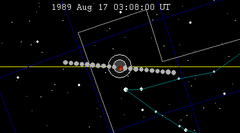
August 1989 lunar eclipse
Encyclopedia


Lunar eclipse
A lunar eclipse occurs when the Moon passes behind the Earth so that the Earth blocks the Sun's rays from striking the Moon. This can occur only when the Sun, Earth, and Moon are aligned exactly, or very closely so, with the Earth in the middle. Hence, a lunar eclipse can only occur the night of a...
took place at 0308 UT (GMT) on August 17, 1989, the second of two total lunar eclipses in 1989.
The moon passed through the center of the Earth's shadow.
Visibility
It was seen completely over South America, and rising over North America, and setting over Africa, and Europe.
Lunar year series
This eclipse is the second of four lunar year eclipses occurring at the moon's ascending node.The lunar year series repeats after 12 lunations or 354 days (Shifting back about 10 days in sequential years). Because of the date shift, the Earth's shadow will be about 11 degrees west in sequential events.
Metonic series
It is the third of five Metonic cycleMetonic cycle
In astronomy and calendar studies, the Metonic cycle or Enneadecaeteris is a period of very close to 19 years which is remarkable for being very nearly a common multiple of the solar year and the synodic month...
eclipses, each being separated by 19 years:

